Welcome to exploring the ten best beautiful places in Nara, where Japan’s rich history, stunning natural landscapes, and cultural heritage converge.
From the serene beauty of Nara Park, home to the sacred deer and ancient temples, to the mystical heights of Mount Yoshino, famed for its cherry blossoms, Nara offers a tapestry of memorable sights.
Join us as we delve into each location, uncovering the charm and significance that make Nara a must-visit destination for those seeking to experience the depth of Japan’s historical and natural wonders.
Whether you are a history enthusiast, nature lover, or cultural explorer, Nara has a beauty that captivates all who wander its paths.
- Recommended BEST Tours in Nara
- Recommended Nara Hotels
- Cheap Flights, Airline Tickets & Plane Tickets (TRIP.COM)
Number 10: Wakakusa Yamayaki.
Starting our countdown at number 10, the Wakakusa Yamayaki is not merely a festival but a dramatic and historic event that lights up the city of Nara each year. Held annually on the fourth Saturday of January, this festival involves setting the dead grass on the slopes of Mount Wakakusayama ablaze, a tradition that dates back hundreds of years.
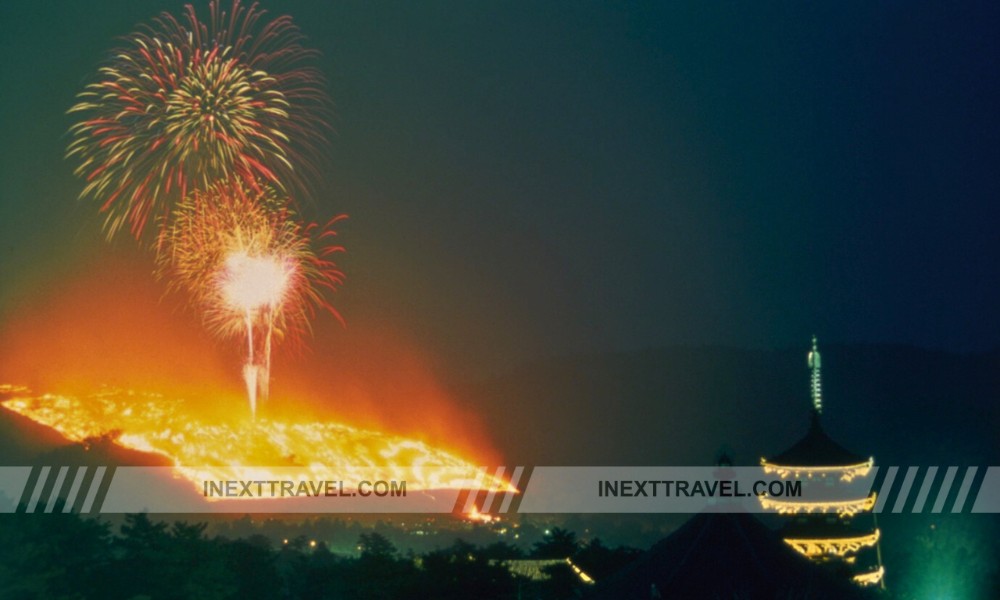
The festival’s origins are somewhat unclear. Still, it is widely believed to symbolize the resolution of boundary disputes between Nara’s great temples, Kofuku-ji and Todai-ji. This fiery testament to the city’s rich historical tapestry is a fitting celebration.
The Wakakusa Yamayaki begins with a grand ceremony attended by hundreds of spectators who gather to witness this unique spectacle. The event starts with traditional music and performances, including taiko drumming reverberating through the air, heightening the anticipation.
As the sun sets, torches are lit, and monks from the local temples lead a procession up the mountain. The ceremonial fire is then used to ignite the mountain’s grassy slopes, setting off a blaze that can be seen for miles around.
While controlled, the fire spreads quickly across the hill, creating a stunning visual against the night sky. The flames illuminate the surroundings, casting a warm glow reflecting off the awestruck crowd’s faces.
The sight of the entire hillside engulfed in flames is both awe-inspiring and somewhat surreal, providing a powerful spectacle that attracts photographers and cultural enthusiasts from around Japan and the world.

The fireworks burst into the sky as the hill burns, adding to the festival’s allure and creating a brilliant display that celebrates Nara’s enduring spirit and beauty. The festival offers a night of breathtaking visuals and a moment of communal reflection, reminding spectators of the passage of time and the transient nature of life, themes deeply embedded in Japanese culture.
The Wakakusa Yamayaki is more than just a festival; it is a profound cultural expression that combines history, spirituality, and community in a fiery display of unity and renewal.
For those visiting Nara, experiencing the Wakakusa Yamayaki offers a once-in-a-lifetime opportunity to engage with the city’s traditions and witness a spectacle that beautifully blends nature and human craftsmanship.
Number 9: Nara National Museum.
At number 9, the Nara National Museum, located in the verdant expanses of Nara Park, stands as a cornerstone of cultural heritage and a guardian of Japan’s rich Buddhist artistic legacy.
This esteemed institution, founded in 1889, is dedicated to preserving and interpreting various Buddhist art forms. It is one of Japan’s most important museums specializing in Buddhist art.

The museum’s collection is vast and varied, featuring an impressive array of statues, painted scrolls, and ritual objects that span centuries of religious expression and artistic achievement.
These artifacts highlight the skill and devotion of their creators and offer insights into Buddhism’s spiritual and historical journey in Japan. Each piece tells a story, from developing Buddhist iconography to transmitting Buddhist teachings across Asia.
One of the museum’s highlights is its annual Shōsōin Exhibition, which displays treasures from the Shōsōin Imperial Repository. These items, many of which are over a thousand years old, include rare silk fabrics, intricate lacquerware, and ancient musical instruments. They provide a unique glimpse into the cultural life of the Nara period. This exhibition is highly anticipated each year and draws scholars and enthusiasts worldwide.
The museum is divided into two main buildings: the original building, a fine example of Meiji-era architecture, and a newer wing added to accommodate the growing collection and visiting exhibitions.
The design of these spaces is carefully considered to enhance the viewing experience. They are tranquil galleries that allow the art to speak for itself amidst a backdrop of minimalist elegance.
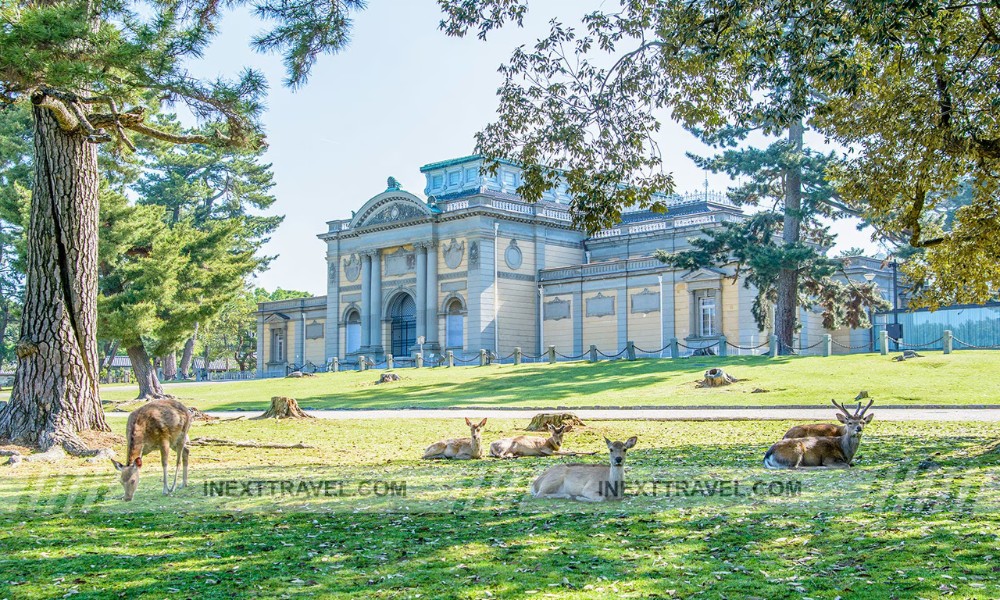
Educational programs and special exhibitions at the Nara National Museum further enrich visitors’ understanding of Buddhist art and its role in society. These programs, often featuring lectures, guided tours, and interactive workshops, make the museum an active educational hub, engaging audiences of all ages and backgrounds.
Visiting the Nara National Museum offers a profound experience where beauty and spirituality converge. Visitors can immerse themselves in the depths of Buddhist art and leave with a greater appreciation of its impact on Japanese culture and history. For anyone seeking to understand Japan’s artistic and spiritual heritage, the Nara National Museum is an indispensable destination.
Number 8: Yoshikien Garden.
At number 8, Yoshikien Garden is a hidden gem nestled in the heart of Nara. This picturesque garden, often overshadowed by its more famous neighbor, Isuien Garden, offers a tranquil retreat for those seeking peace and natural beauty.
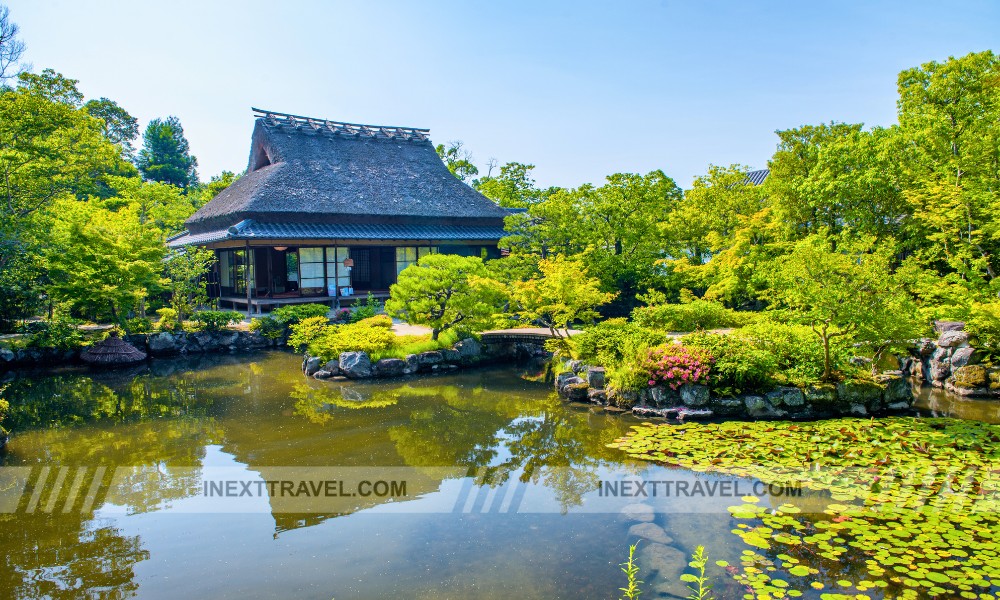
Named after the nearby Yoshikigawa River, Yoshikien Garden is distinguished by its three distinct garden areas: the moss garden, the pond garden, and the tea ceremony garden, each offering a unique landscape experience.
The moss garden is perhaps the most enchanting section. A lush carpet of vibrant green moss covers the ground, creating a soft, serene atmosphere that feels almost otherworldly.
This garden is lovely after rain when the moss appears even more vivid, and the air is fresh with the scent of damp earth and vegetation. The tranquility of the moss garden makes it an ideal spot for meditation or quiet contemplation.
Adjacent to the moss garden is the pond garden, which features a central pond surrounded by meticulously landscaped rocks, trees, and shrubs. The pond acts as a mirror, reflecting the changing skies and the seasonal beauty of the surrounding flora.
Koi fish glide beneath the surface, adding a dynamic element to the otherwise still water. The interplay of reflection, water, and life makes the pond garden delightful for strolls and photography.
The third area, the tea ceremony garden, includes a traditional tea house where visitors can experience Japanese tea culture. The tea house looks out over the garden, providing a perfect backdrop for savoring a bowl of matcha and seasonal Japanese sweets. This garden area emphasizes the historical and cultural connection between tea ceremony practices and Japanese garden aesthetics.
Together, these three gardens of Yoshikien offer a comprehensive experience of traditional Japanese landscaping art. The garden’s design utilizes natural elements to create scenes that evoke the larger natural world, embodying the principles of scale, balance, and harmony. Each visit can feel different as the gardens change with the seasons, from the fresh, verdant greens of spring to the rich colors of autumn.
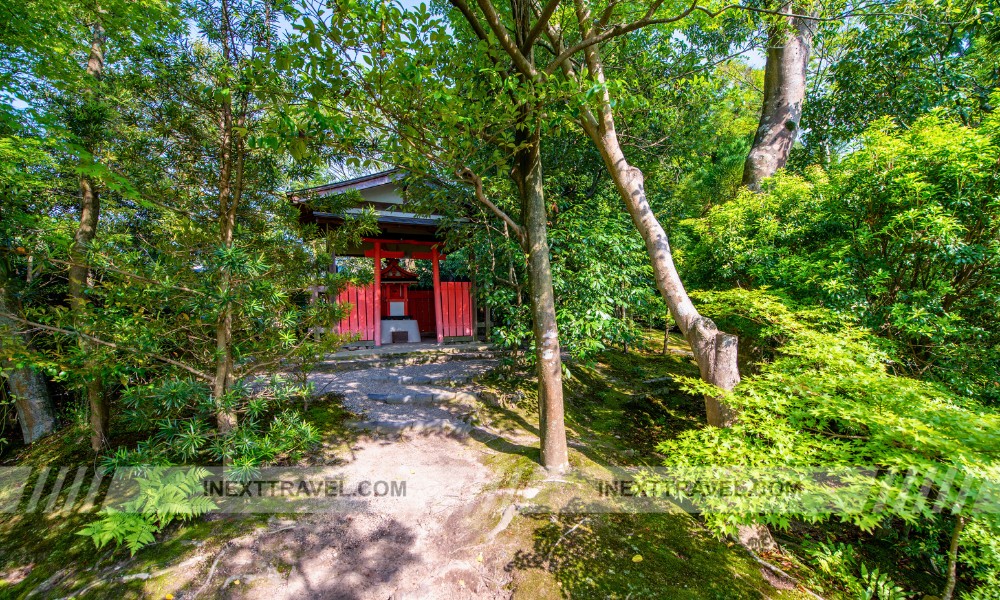
For visitors to Nara looking for a peaceful escape from the bustling tourist paths, Yoshikien Garden provides a quiet, beautiful space to reconnect with nature and experience the refined beauty of Japanese garden design.
Whether you come to ponder the delicate details of the moss, relax by the reflective pond, or partake in a calming tea ceremony, Yoshikien Garden offers a slice of tranquility and traditional elegance.
Number 7: Heijo Palace.
At number 7, Heijo Palace is a monumental link to Japan’s ancient past, particularly the Nara period, when it served as Japan’s imperial residence and administrative center.
Established in the late 8th century when Nara (then called Heijo-kyo) was the capital of Japan, this sprawling palace complex was the heart of political power and cultural life during one of the most flourishing periods of Japanese history.
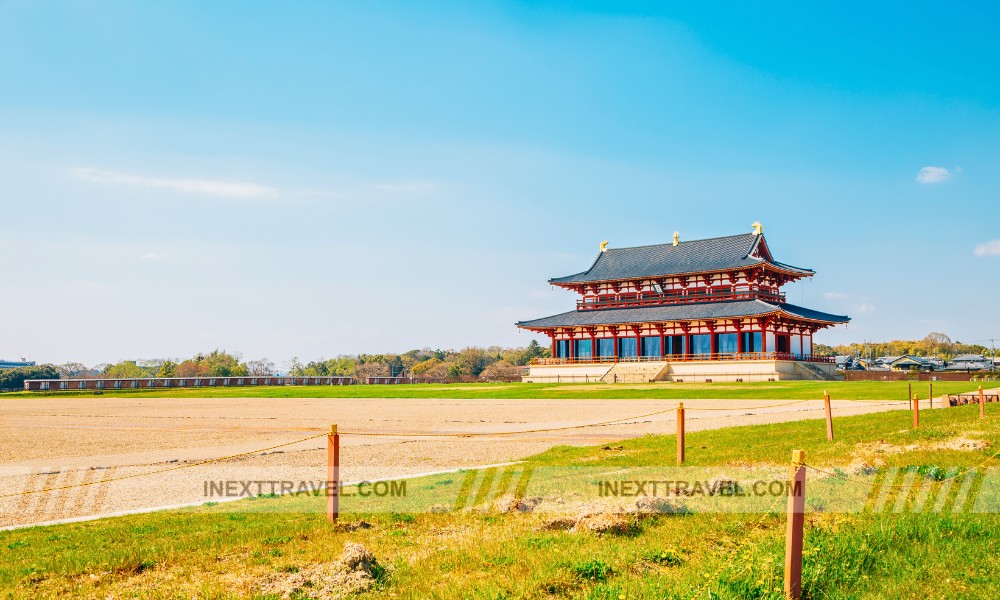
Today, Heijo Palace is an expansive archaeological site partially reconstructed to give visitors a sense of its former grandeur. Key features of the palace, such as the Daigokuden, the primary audience hall where emperors conducted official affairs and held court ceremonies, have been meticulously rebuilt based on historical records and archaeological findings. This reconstruction allows visitors to step back in time and imagine the splendor and scale of the original structures.
In addition to the reconstructed buildings, much of the palace remains in ruins, preserved as archaeological sites that are open for public viewing. These ruins are scattered across the extensive grounds and include the foundations of former government offices, ceremonial sites, and residential areas. Walking through these ruins, visitors can better understand Japan’s ancient capital’s architectural and cultural context.
The site also features the Heijo Palace Museum, which provides valuable insights into the life and times of ancient Nara through a rich collection of artifacts recovered from the site, including ceramics, roof tiles, and other relics used in the daily life of the palace. The museum’s exhibits and interactive displays enhance the visitor experience by painting a vivid picture of the historical significance of Heijo Palace.
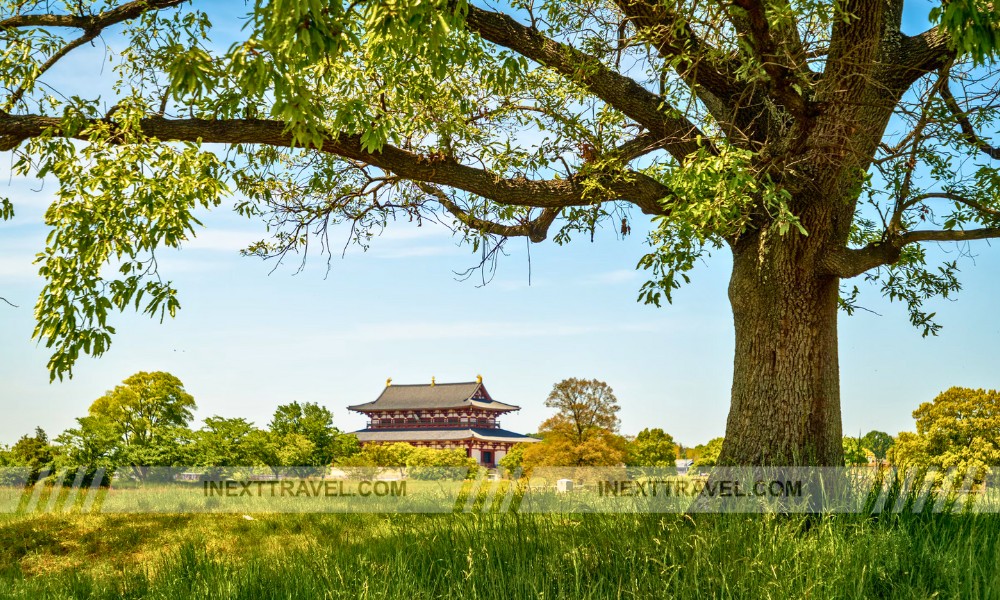
Heijo Palace is not just a tourist attraction but a culturally significant site that offers a unique educational experience. Its vast grounds and serene environment make it perfect for leisurely walks and in-depth historical exploration.
A visit to Heijo Palace is essential for anyone interested in Japan’s ancient history and architectural heritage. It provides a tangible connection to the country’s Nara-period legacy and a deeper appreciation of its historical landscape.
Number 6: Kasuga Taisha.
Number 6 on our list is Kasuga Taisha, Nara’s most revered Shinto shrine, celebrated for its deep historical significance and breathtaking beauty. Founded in the 8th century to protect the city, Kasuga Taisha is known for its close association with the Fujiwara family, one of the most powerful clans in Japanese history. This shrine is a spiritual center and a stunning example of traditional Japanese architecture and symbology.
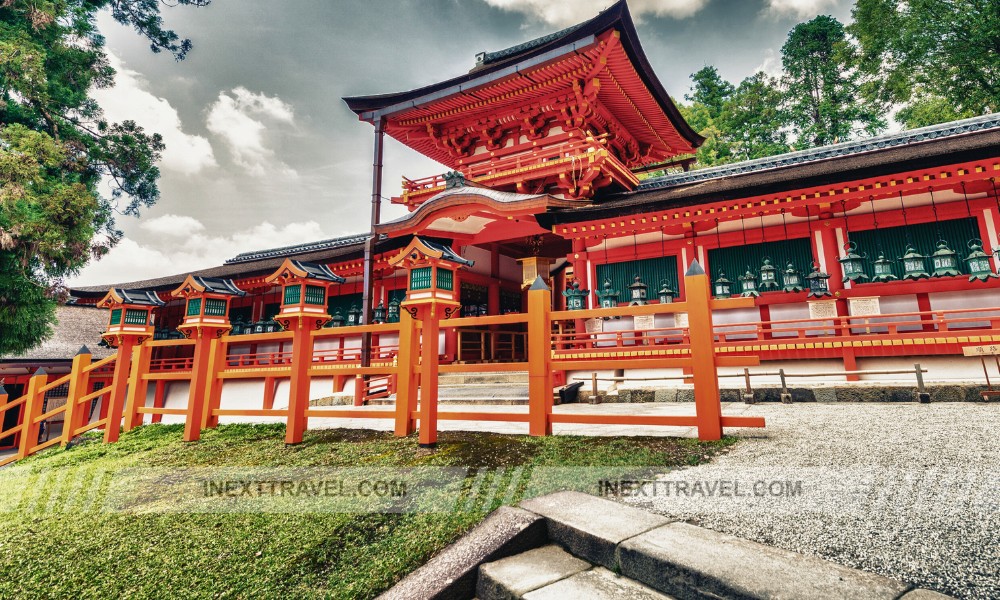
One of the most enchanting features of Kasuga Taisha is its collection of thousands of bronze and stone lanterns. These lanterns, donated by worshipers over centuries, line the pathways to the shrine, creating an atmospheric approach that changes with the seasons, from cherry blossoms in spring to colorful leaves in fall.
The site is especially magical during the Lantern Festivals in February and August, known as “Setsubun Mantoro” and “Chugen Mantoro,” respectively, when all the lanterns are lit up at night. The illumination transforms the shrine into an ethereal space, with light filtering through the trees and reflecting off the mossy ground, creating a serene and otherworldly ambiance.
In addition to the lanterns, the shrine is famous for its vermilion-painted buildings, which stand out vividly against the lush green backdrop of the surrounding ancient forest. The architecture of Kasuga Taisha is noted for its ornate and intricate woodwork, which features detailed carvings of deities and symbols meant to protect and bless the shrine.
Visitors can also explore the many auxiliary shrines within the complex, each dedicated to different gods and goddesses associated with the Kasuga deity family. This provides a deeper understanding of Shinto practices and the polytheistic nature of Japanese spirituality. The shrine also hosts various traditional rituals and ceremonies throughout the year, and it is open for visitors to observe and offer a chance to experience Japan’s cultural heritage.
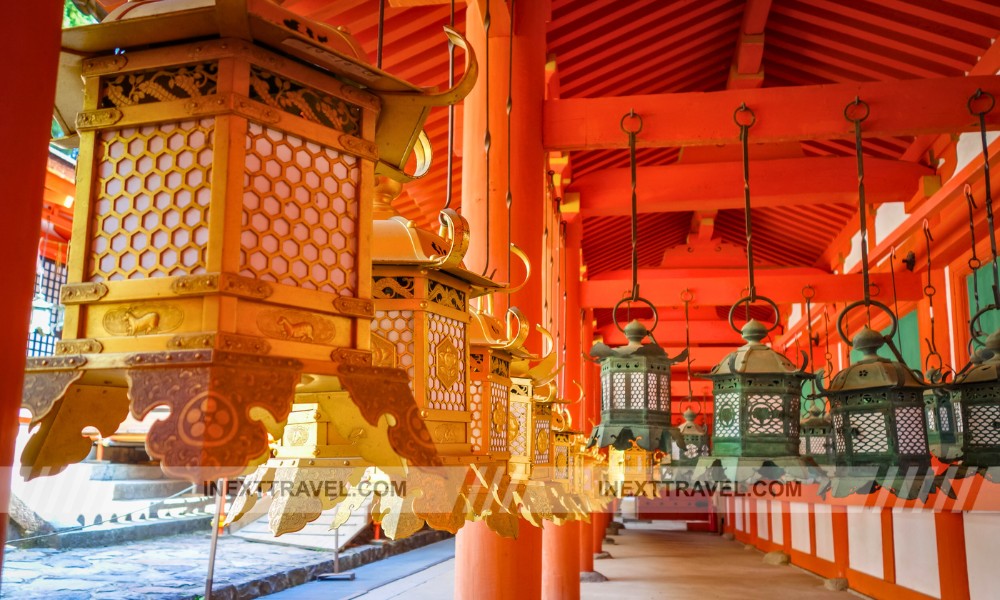
Moreover, the shrine’s location in Nara Park, where visitors can interact with free-roaming deer considered messengers of the gods, adds to Kasuga Taisha’s spiritual and historical richness. The connection between nature, wildlife, and spirituality visits this shrine, which is a profound experience that captures the essence of Nara’s spiritual landscape.
Kasuga Taisha is not just a place of worship but a cultural landmark that offers visitors a glimpse into the spiritual heart of Japan. It remains a must-visit for anyone wanting to experience the traditional rituals, architectural beauty, and peaceful ambiance that define Nara.
Number 5: Naramachi.
At number 5, we visit Naramachi, a charming and historically rich district in Nara that was once the bustling merchant quarter of the city. This area retains much of its old-world charm, characterized by narrow alleys and traditional machiya houses.
These wooden townhouses, dating back to the Edo period, were built initially as combined homes and workplaces for local merchants and artisans. They uniquely reflect the architectural style and urban culture of historic Nara.
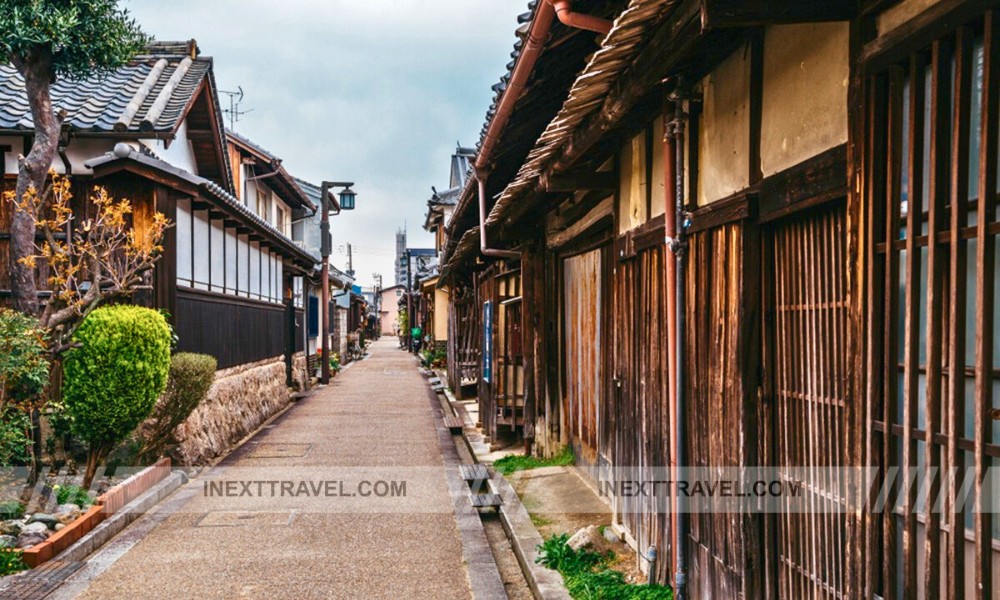
Today, Naramachi has transformed into a delightful neighborhood where the past and present merge seamlessly. As you stroll through its alleys, you’ll find that many of these machines have been carefully preserved and repurposed for various modern uses.
They now house quaint shops, cozy cafes, and small museums, offering visitors a unique window into the lifestyle and aesthetics of bygone eras. These establishments often retain traditional architectural elements such as lattice façades and inner gardens, providing an authentic atmosphere that transports visitors back in time.
Naramachi also offers cultural experiences that allow visitors to engage more deeply with the local history and crafts. Workshops and demonstrations, ranging from Japanese calligraphy to the crafting of traditional Nara dolls, are available, giving hands-on insights into the craftsmanship preserved through generations. Additionally, some machines host exhibitions about the district’s history and evolution from a merchant area to a cultural hub, enriching visitors’ understanding of Nara’s heritage.
Beyond the commercial and cultural offerings, the district’s layout and design contribute to its unique atmosphere. The narrow streets encourage leisurely exploration, inviting visitors to wander and discover hidden gems such as tiny but beautifully maintained private gardens and intricately carved wooden details that adorn the machine exteriors.
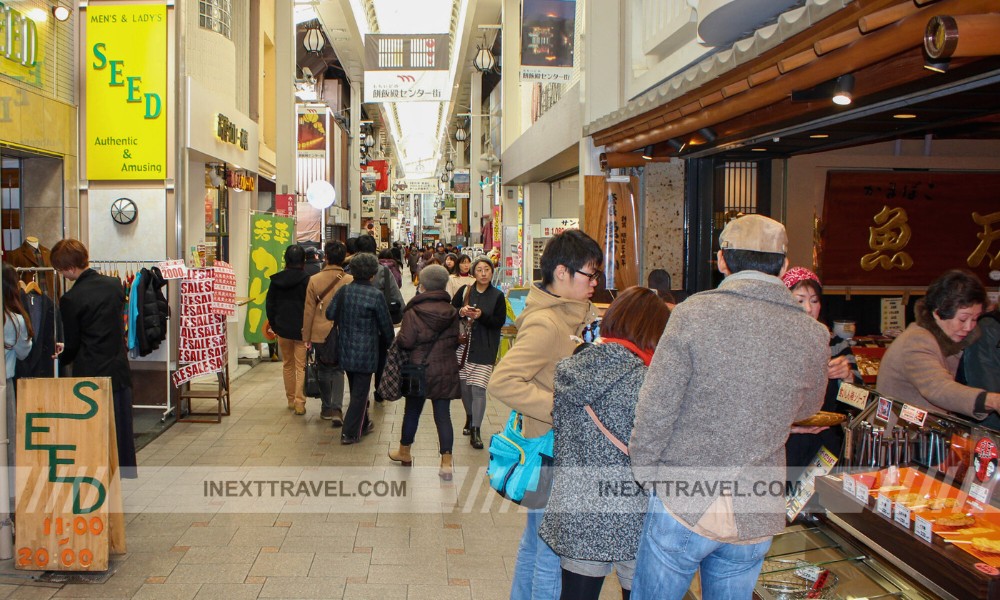
Naramachi is not just a place to shop and eat; it’s a cultural experience that offers a palpable sense of Nara’s historical continuum. Every corner tells a story, making it an essential destination for anyone interested in Nara’s authentic charm and history.
Whether browsing artisanal goods, sipping tea in a converted machiya, or exploring a local museum, Naramachi provides a picturesque and historically rich backdrop that is quintessentially Nara.
Number 4: Mount Yoshino.
At number 4, Mount Yoshino stands as a pinnacle of natural beauty and cultural significance, widely acclaimed as the best cherry blossom viewing spot in Japan. Known in Japanese as Yoshinoyama, this mountain is not merely a location but a phenomenon that embodies the deeply rooted cultural appreciation for cherry blossoms, or sakura, that permeates Japanese culture.
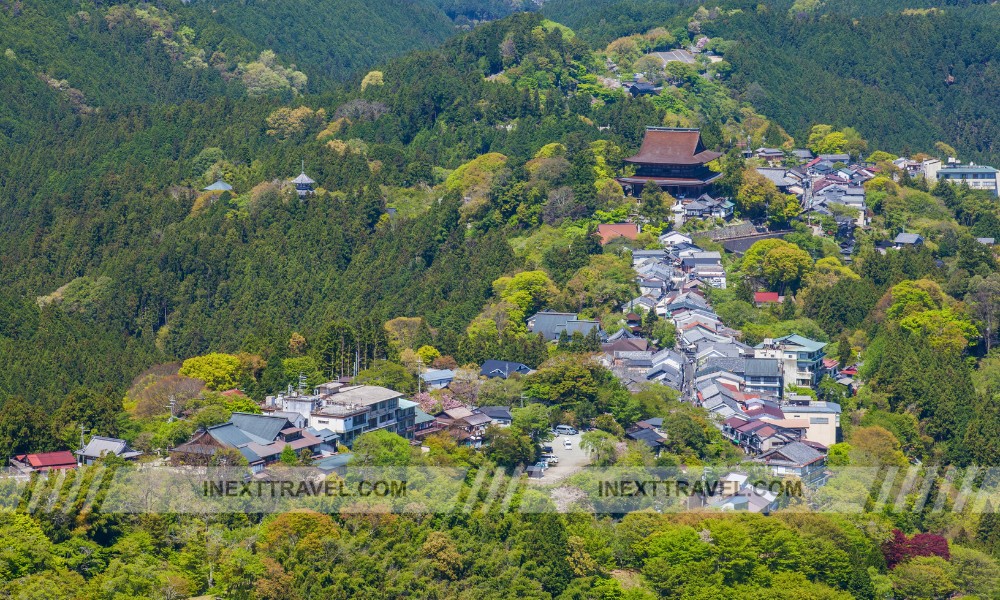
Every spring, Mount Yoshino is adorned with a breathtaking blanket of over 30,000 cherry trees that burst into vibrant hues of pink and white. The spectacle is so grand that the mountain seems to come alive, painted in waves of color cascading down its slopes.
This stunning display is categorized into four areas – Shimo Senbon (lower thousand trees), Naka Senbon (middle thousand trees), Kami Senbon (upper thousand trees), and Oku Senbon (inner thousand trees) – each offering a slightly different stage of bloom as the elevation increases.
The history of cherry blossom viewing at Mount Yoshino dates back over a thousand years, and it has been celebrated by poets, emperors, and ordinary folk throughout the ages.
The area is steeped in legend and poetry, with many viewing spots and temples dotting the mountain, each offering its own stories and historical significance. The famous poet Saigyo and Emperor Go-Daigo are just a few historical figures who have famously enjoyed the sakura here.
Beyond its visual beauty, Mount Yoshino offers a spiritual experience as well. The mountain is home to several important temples and shrines, including Kinpusen-ji, the head temple of Buddhism’s Shugendo mountain ascetic sect. These religious sites offer a serene environment for contemplation and worship, enhanced by the ethereal backdrop of cherry blossoms.
For visitors, Mount Yoshino’s experience extends beyond the visual spectacle. Local tea houses and vendors offer traditional Japanese refreshments and sakura-themed treats, allowing guests to immerse themselves in the season’s flavors.
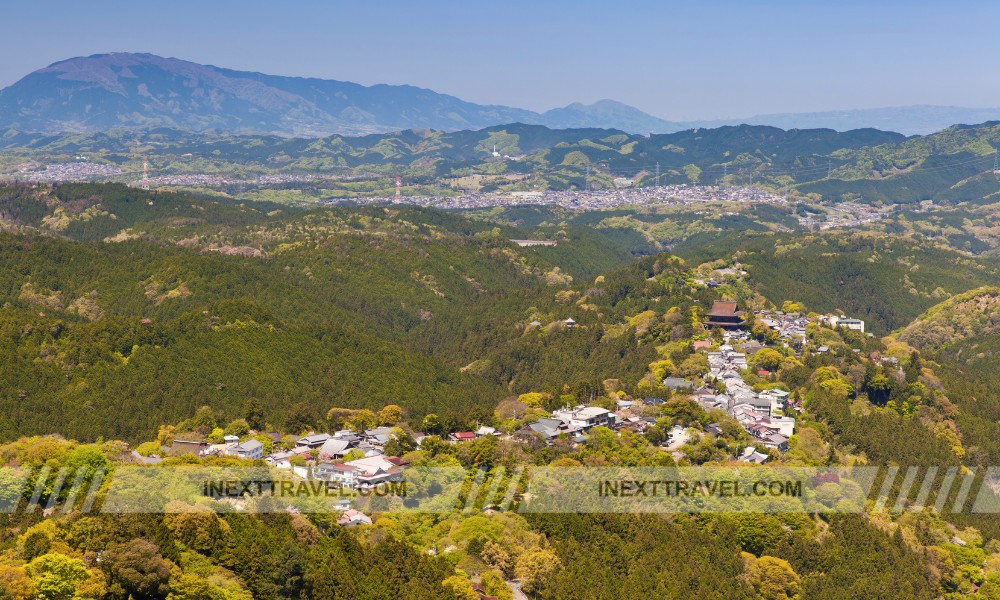
Hiking trails that wind through the cherry trees provide opportunities for physical engagement with the landscape, making a trip to Mount Yoshino a holistic experience that engages all the senses.
In conclusion, Mount Yoshino is more than just a viewing spot; it is a cultural and natural treasure that connects profoundly to Japan’s beauty and history. Its overwhelming beauty during cherry blossom season and the rich historical tapestry surrounding it make it an unforgettable destination for anyone visiting Nara.
Number 3: Todaiji Temple.
At number 3, Todaiji Temple holds a place of profound historical and spiritual importance in Nara. Established in 752 AD during the Nara period, this temple is renowned for its staggering architectural achievements and as a center of Buddhist scholarship and practice.
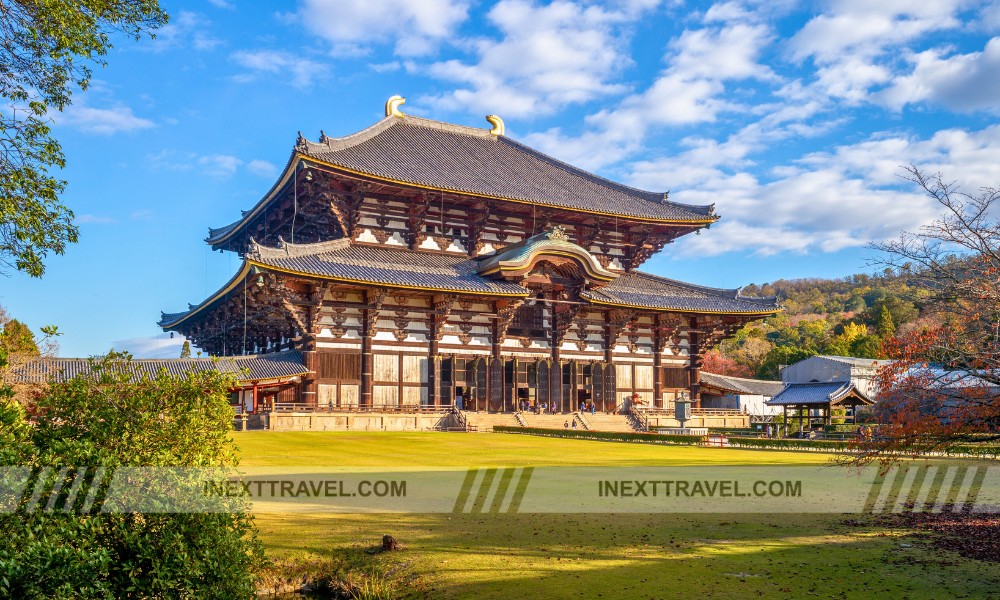
It houses the world’s most giant bronze statue of the Buddha Vairocana, known in Japanese as Daibutsu. This monumental testament to ancient Japan’s religious devotion and artistic ingenuity is a must-see.
The Daibutsu is housed in the Daibutsuden (Great Buddha Hall), which is recognized as the world’s largest wooden building. Despite its current structure being a reconstruction at two-thirds the size of the original, it remains imposing, both in scale and in the craftsmanship it showcases.
The massive building, constructed mainly of wood and roofed with ceramic tiles, is an architectural marvel that has survived numerous natural disasters, albeit with necessary restorations.
The presence of the giant Buddha statue within such a grand structure is awe-inspiring. The statue stands approximately 15 meters tall and consists of several hundred tons of bronze and gold.
It was initially cast in the 8th century, and over the centuries, it has been recast and repaired after damages due to earthquakes and fires. The Buddha is seated in the lotus position with a serene expression, symbolizing cosmic benevolence and internal peace, inviting awe and reverence from all who visit.
Todaiji Temple also serves as the headquarters of the Kegon school of Buddhism, deeply rooted in the philosophies and teachings that influenced its construction. The temple complex includes additional halls, such as the Nigatsudo and Sangatsudo, which hold significant cultural and religious artifacts and are essential sites for various rituals and ceremonies observed throughout the year.
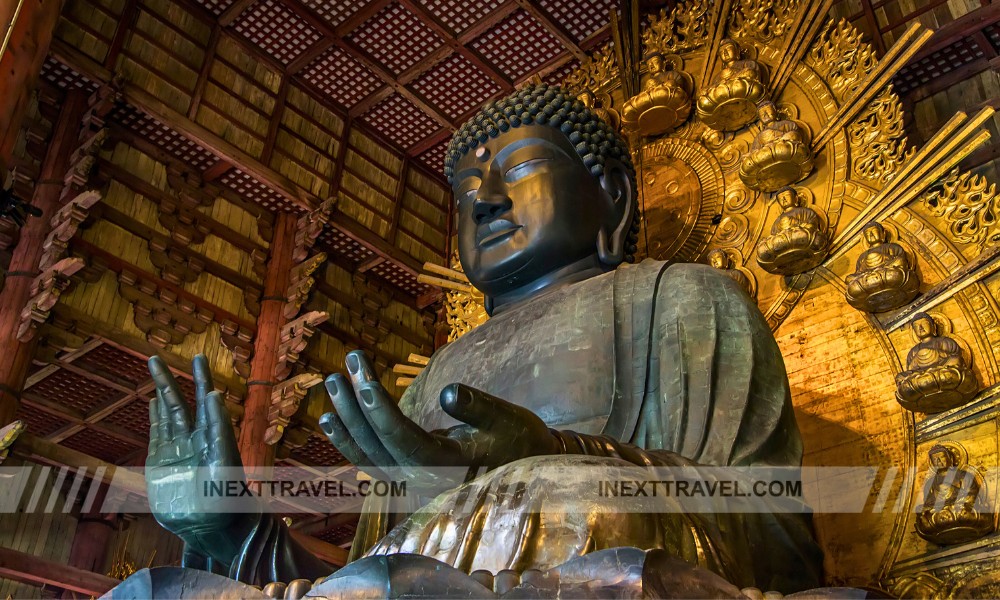
Visitors to Todaiji Temple can explore the sprawling temple grounds, where deer from the adjacent Nara Park roam freely, adding to the serene and welcoming atmosphere of the temple.
The temple offers a window into Japan’s spiritual and artistic heritage and provides a tranquil space for reflection and connection, making it a focal point for pilgrims and tourists alike.
In essence, Todaiji Temple is much more than just a tourist destination; it is a vibrant cultural hub that encapsulates the spiritual heart of Nara. Its historical significance, architectural grandeur, and the profound tranquility that pervades its precincts make it an essential experience for anyone visiting Nara.
Number 2: Isuien Garden.
At number 2, Isuien Garden is a traditional Japanese landscape design pinnacle. It offers a serene and meticulously maintained space that captures the essence of natural beauty and tranquility.
Located in the heart of Nara, this garden is unique. It comprises two distinct sections, each developed during different historical periods, yet both harmoniously blended to create a seamless and immersive experience.
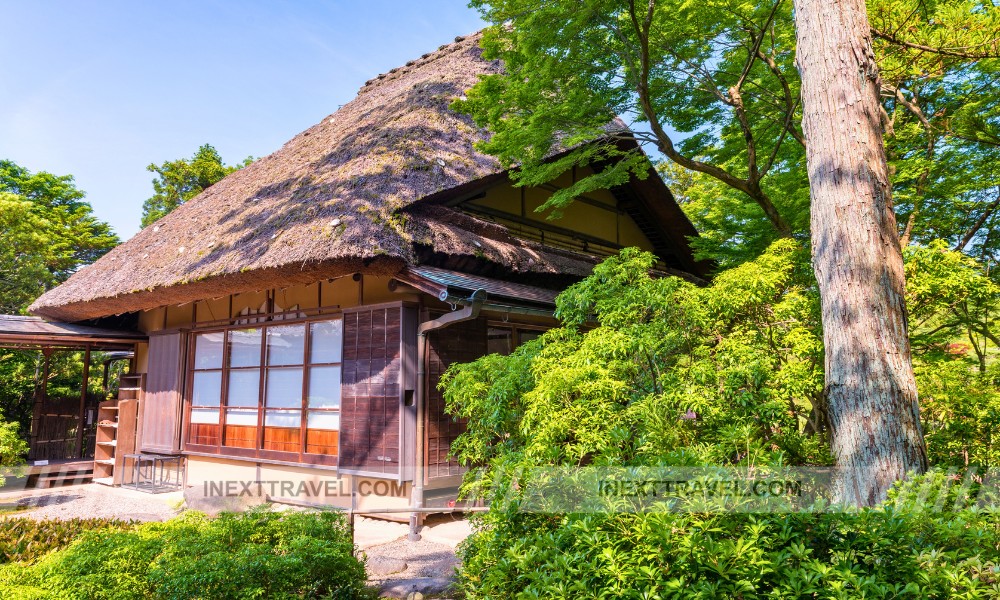
The first section of Isuien Garden was established in the mid-17th century and features a classical strolling-style garden, where every path and bridge has been thoughtfully placed to offer picturesque views from every angle.
This part of the garden uses the borrowed scenery (shakkei) technique, incorporating the distant hills of Nara as a backdrop to enhance the depth and beauty of the landscape. The winding streams and strategically placed stones guide visitors through various vistas, each carefully framed as living paintings.
The second, newer section of the garden was added in the late 19th century and continues the theme of tranquil beauty with larger ponds, expansive lawns, and a collection of trees and plants that change character with the seasons.
This area further expands the garden’s scenic diversity. It features a large pond that mirrors the sky and surrounding foliage, creating a profound sense of peace and reflection. The tea houses around the pond provide spaces for rest and contemplation, allowing visitors to soak in the serene atmosphere and the artful landscape.
Both sections of Isuien Garden are designed to showcase the subtle beauty of nature and evoke a deep sense of calm and introspection. The garden’s layout encourages slow, meditative walks, with each turn and crossing designed to reveal a new perspective or a hidden detail, from the soft moss underfoot to the carp gliding silently in the water.
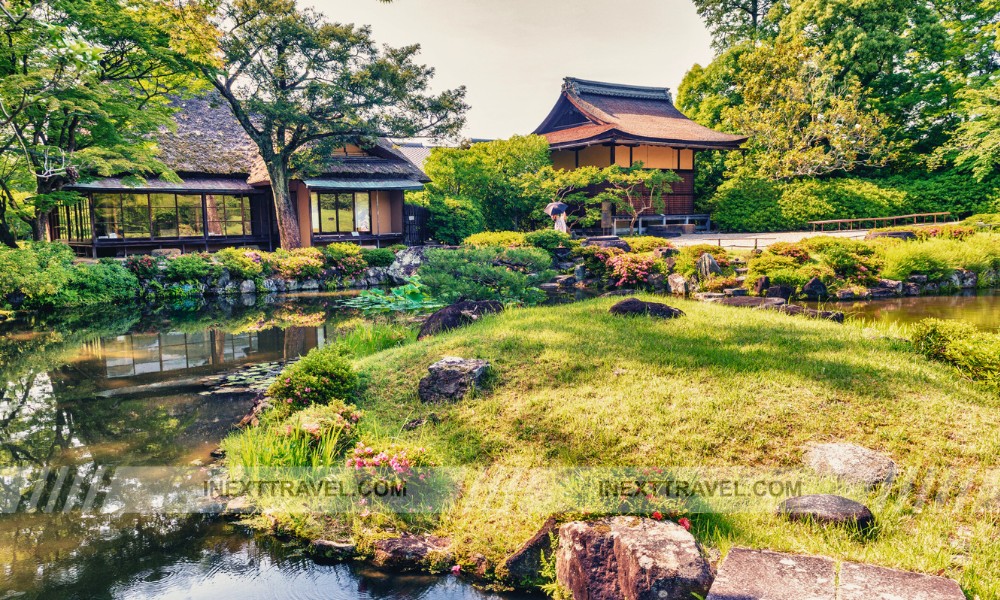
The careful curation of plant life, water features, and rocks in Isuien Garden exemplifies the Japanese aesthetic principle of wabi-sabi, which finds beauty in simplicity, impermanence, and imperfection. Visiting Isuien Garden offers a retreat from the bustling outside world, where nature’s impermanent beauty can be appreciated in its whole form.
For anyone visiting Nara, Isuien Garden is a must-see destination. It reflects the mastery of Japanese gardening and provides a tranquil haven where the beauty of each season can be appreciated in a setting of profound peace and natural elegance.
Number 1: Nara Park.
And at number 1, Nara Park, affectionately known as ‘Deer Park,’ stands as the iconic centerpiece of Nara. This expansive and scenic park is the city’s most significant green space and spiritual and cultural heart. It draws visitors worldwide to experience its unique blend of natural beauty and historical significance.
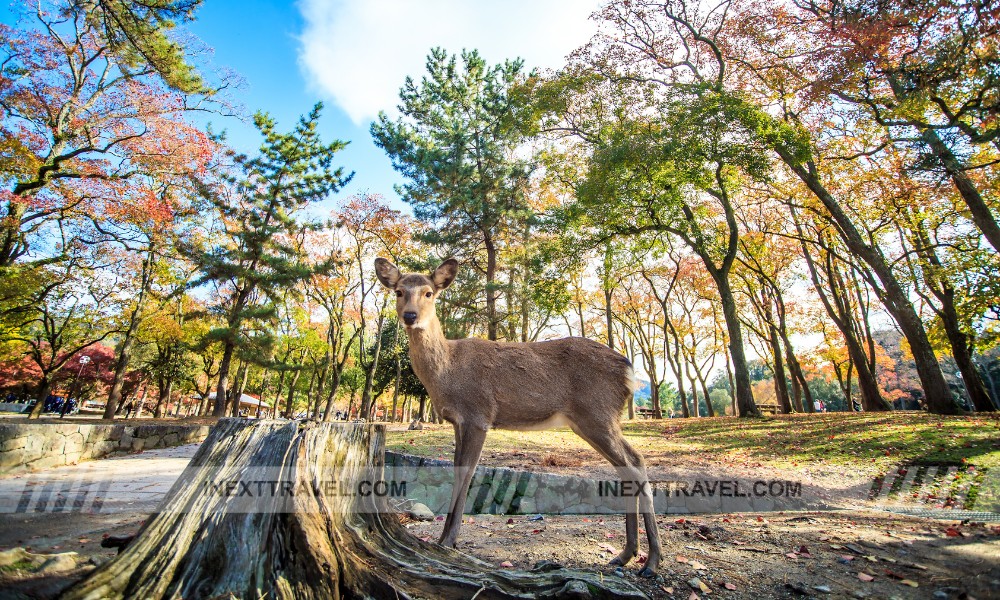
Nara Park is renowned for its hundreds of freely roaming deer, which have become symbolic of the city itself. According to local Shinto belief, these deer are considered sacred messengers of the gods, protected and treasured throughout the ages.
Visitors to the park can interact with these gentle creatures, feeding them with special deer-safe crackers available for purchase within the park. This interaction is not just a tourist attraction but a way to connect with Nara’s cultural and spiritual traditions.
Spanning over 502 hectares, Nara Park encompasses lush forested areas, open lawns, and serene ponds, creating a diverse landscape that changes beautifully with the seasons. From the vibrant cherry blossoms of spring to the rich reds and golds of autumn, the park offers a picturesque setting that enchants any visitor with its tranquil beauty.
Moreover, Nara Park is home to several of Nara’s most famed historical and religious sites, including Todaiji Temple, home to the world’s most giant bronze Buddha statue, and Kasuga Taisha, known for its lantern-lined pathways.
These landmarks not only enhance the park’s cultural value but also provide a deep insight into the historical depth of the city. Each temple and shrine within the park tells a story, contributing to the rich tapestry of Nara’s history.
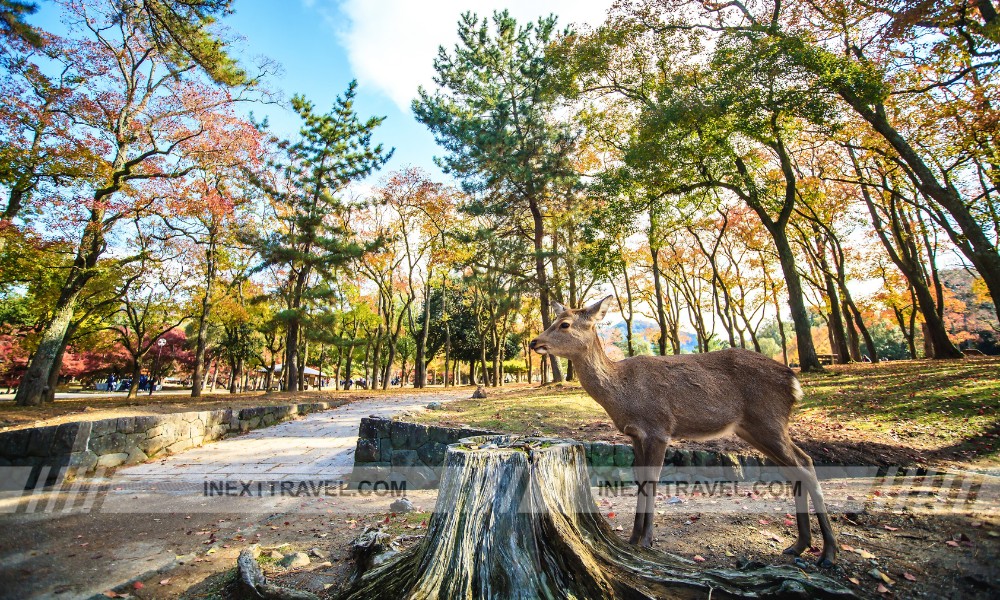
The park also has walking paths, picnic areas, and traditional tea houses where visitors can relax and enjoy the natural and peaceful environment. Whether wandering through its vast expanses, partaking in a traditional tea ceremony, or exploring its ancient temples, Nara Park offers a comprehensive experience combining leisure, culture, and spirituality.
Nara Park’s combination of natural beauty, cultural heritage, and spiritual significance makes it more than just a city park—it is a living museum and a vibrant testament to Nara’s historical legacy and its ongoing cultural traditions.
It is a place where nature and history are intertwined, offering visitors a profound sense of place and timelessness; for anyone visiting Nara, a day spent in Nara Park is spent in the heart and soul of the city.
Conclusion
As we conclude our journey through the ten best beautiful places in Nara, it’s clear that this ancient city offers a unique blend of natural beauty, profound history, and tranquil spirituality that is both captivating and enriching.
Each location we’ve explored, from the verdant tranquility of Isuien Garden to the historic grandeur of Todaiji Temple, contributes to the rich tapestry that defines Nara.
These sites showcase the city’s aesthetic beauty and cultural depth and provide a peaceful escape where history and nature intertwine seamlessly.
Whether it was the serene pathways lined with thousands of cherry trees on Mount Yoshino or the friendly deer roaming freely in Nara Park, each place has left an indelible mark on our hearts.
We hope this guide inspires you to explore these stunning locations in Nara for yourself, to walk in the footsteps of history, and to find a moment of peace away from the hustle and bustle of modern life.
Each visit promises a visual feast and a deeper connection with this historic city’s cultural and natural heritage.
So pack your bags and prepare to be enchanted by the timeless beauty of Nara.
Safe travels, and may your journey be filled with many beautiful discoveries!